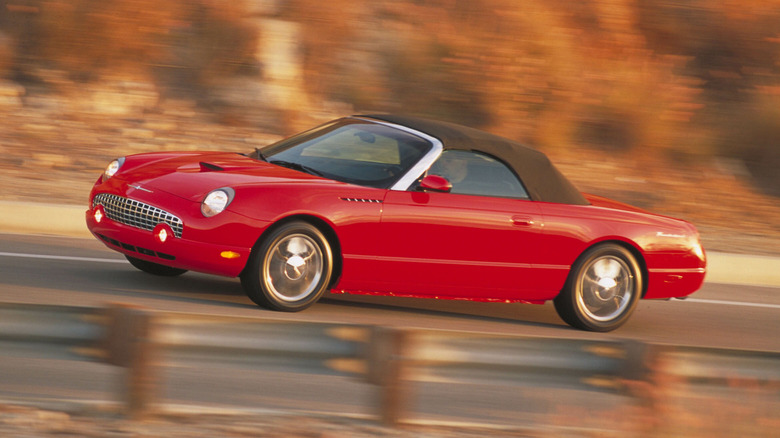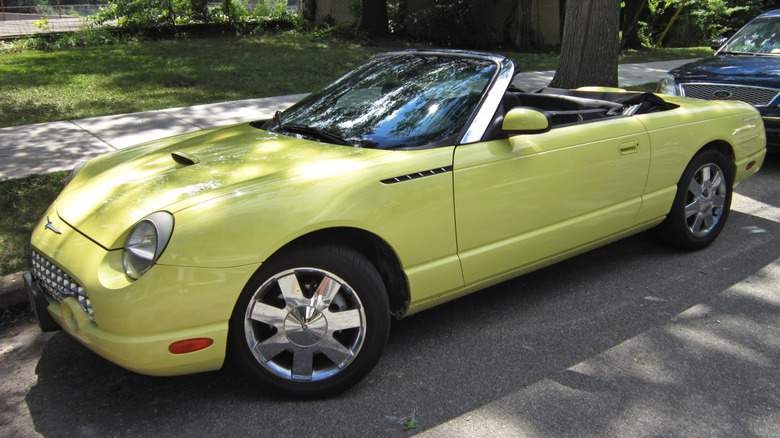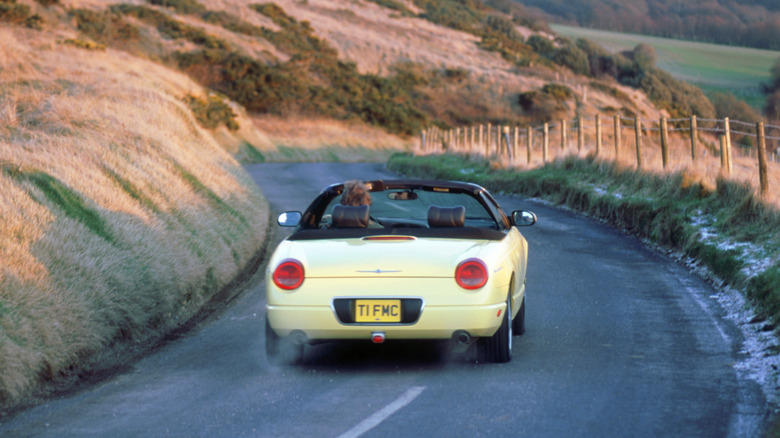This Is What Killed Ford's Short-Lived T-Bird Reboot
It's hard to overstate just how big the auto industry's retro movement was during the late 1990s and early 2000s. From inexpensive compact cars like the Volkswagen New Beetle to the high-end Ford GT, there was no shortage of retro-styled machines brought to the market, and they were met with varying degrees of success. The New Beetle was a cultural phenomenon when it came out. The Chrysler PT Cruiser? Sure, people liked to make fun of it, but it was a hit among buyers, with Chrysler moving over a million units before the PT Cruiser was discontinued in 2010.
Then there was the reborn, retro-styled Ford Thunderbird, which first appeared in 1999 as a concept car and went on to be in production from the 2002 to 2005 model years. Though the new Thunderbird looked the part and generated some hype initially, the car never took off the way Ford had hoped. Sales figures were promising initially, but soon nosedived, with less than 70,000 cars sold across its four model years.
The Thunderbird had such a short life because of its high price. Apart from its eye-catching looks, the Thunderbird didn't really excel at anything. It wasn't particularly fast, it didn't handle like a sports car, it wasn't very practical, and despite having shared Jaguar underpinnings and a Jaguar engine, it wasn't as luxurious or refined as its European competition.
A compromised formula
Both the styling and the general feel of the new Thunderbird were inspired by the original Thunderbirds of the mid-1950s, which meant two seats and a convertible top. But its underpinnings were anything but old-school Ford. The car rode on the ambitious and expensive Ford DEW98 platform, which was also used by the Jaguar S-Type and Lincoln LS sedan.
Mechanically, the Thunderbird was one of the prime products of Ford's former ownership of Jaguar. It used a version of Jaguar's 3.9-liter DOHC V8 engine that made reasonable power and delivered the right sounds, but when mated to a five-speed automatic transmission, it ultimately fell short of the performance many expected from a two-seat V8 roadster. And with a weight of nearly 3,800 pounds, the Thunderbird also wasn't going to be out-handling any Corvettes in the corners.
The Thunderbird still made for a capable grand touring car, though the limited interior space, a lack of headroom, and interior materials that some felt were cheap, limited its appeal among the baby boomer customers it was targeting. Combine all that with a starting price that during its final model year would be equivalent to over $62,000 in today's dollars, and it's not hard to see why demand fell off and Ford killed the car after a few years.
Will Thunderbird return?
Once you got past the styling, the Thunderbird was stuck somewhere between the much faster Corvette, the much cheaper Mustang GT, and the more refined and better-driving convertibles from Europe. This isn't to say that the retro Thunderbird was a complete failure. Its styling was a big deal and provided tremendous curb appeal. And now with the earliest ones nearing 25 years old, it's started to emerge as a bit of an underrated modern classic, with looks that still draw the eye today.
Ford also learned a lot from the Thunderbird, leading to the much more successful retro-styled S197 Mustang that launched for the 2005 model year, just as the Thunderbird was leaving the stage. Initially, the new Mustang was to use the same DEW platform as the Thunderbird, but Ford eventually switched to a cheaper platform that retained some of the DEW's front architecture.
Will the Thunderbird ever come back again? Perhaps as a high-end EV? The internet is full of unsubstantiated rumors and AI renderings (as you'll find with just about any car these days), but as of now, Ford has not hinted at a Thunderbird rebirth at all. It's also hard to say how much brand value the Thunderbird name even has among today's car buyers. Given what happened with the last Thunderbird revival, we wouldn't hold our breath for another one.


